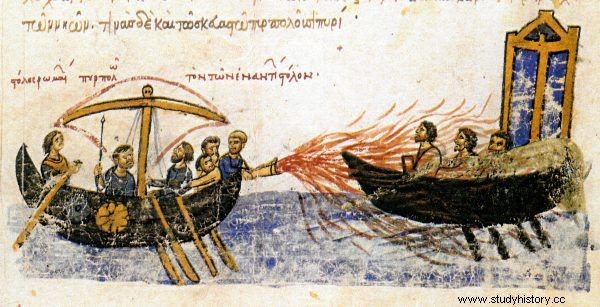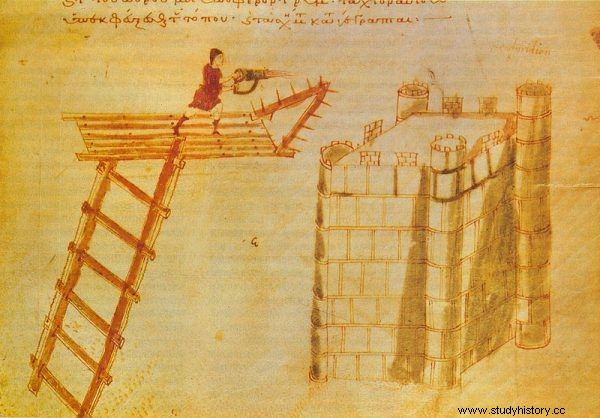This weapon is considered a prototype of napalm and thermonuclear charges. For her contemporaries, the mere memory of her was frightening. There was no escape from her:when she appeared, she carried terror and destruction. No wonder the secret of this weapon was carefully guarded ... so diligently that we still can't recreate it to this day.
A blast of fire, accompanied by thunder and burning smoke - this is how the Byzantine emperor Leo described the operation of the miraculous weapon of Byzantium. The world now knows it as "Greek fire", but it is a much later term. The Byzantines would never call themselves Greeks; after all, they considered themselves continuators of the traditions of ancient Rome.
As reported in his latest book "Byzantine Wars. Strategy, tactics, campaigns ” historian John Haldon, the Byzantine armies have had this formidable weapon since the end of the 7th century. Its inventor is considered to be Callinicus of Heliopolis, a chemist who sought refuge from the Arabs in Constantinople. Of course, firearms were known before, but Kallinikos (and maybe other scientists) managed to improve their composition and the way they were used.
Medieval napalm
The Byzantineologist describes "Greek fire" as "the prototype of napalm, which is an oil-based mixture" . The latter was harvested in the Caucasus or the South Russian steppes. How was the dangerous liquid mixture handled? Author of "Wars of Byzantium" says:
It was ejected from pipes mounted in the bows or amidships of the larger units of the imperial fleet. It seems to be effective when actually used, but it was also an excellent scarecrow. At the beginning of the 10th century, handheld throwers for use on land were developed (…).

The flame extended 50 yards, a little over 45 meters.
The first known use of firearms dates back to 674–678, when the Arabs besieged Constantinople. Her victim then fell to the enemy fleet, which approached the city. A pictorial description of the clash was published in one of his publications by journalist Ernest Volkman:
To meet the [Arabian fleet - ed. A. W.] a few small, fast Byzantine galleys came out. Taking advantage of the greater maneuverability of their smaller ships, the Byzantines approached the Saracen ships while their crew below deck pumped fiercely, one of them, shielded by archers, aiming the nozzle he was holding at the target.
When the fluid has reached the nozzle, [Byzantine - ed. A. W.] he rubbed two pieces of flint together, creating a spark, turning the liquid into a stream of liquid fire that fired at 50 yards. One by one the Saracen ships were engulfed in fire; the rest fled in horror.
The "Greek Fire" quickly became the real terror of the medieval troops. "Although the Arabs even created special units equipped with non-flammable clothing, does not seem like they could do much against this invention ”- reports John Haldon. One can only imagine the torments in which those who were hit by the deadly flame died.

The curiosity was based, among others, on the book by John Halton "Wars of the Byzantines. Strategy, tactics, campaigns ” (Rebis 2019).
Thanks to the secret weapon, Byzantium seemed invincible, and its strongholds - impregnable. Anna Comnena, daughter of Emperor Alexios I Comnenus, described the Battle of the Pisans near Rhodes in 1013. Enemies reportedly watched in horror as the fire, usually directed upward, spread out in every possible direction at the will of the thrower. "It falls on the faces of enemies like a fiery whirlwind" - proudly described the Byzantine heiress.
A closely kept secret
We do not know the exact formula of the killer mixture to this day. The Byzantines guarded it like an eye in their head - they even said that it was ... a gift from God! They argued that it was passed on to posterity by the Emperor Constantine the Great himself, the founder of the capital of the empire. Apparently, the recipe for Greek fire was not allowed to be written down, and the chemists who prepared it swore that they would not reveal the secret. The keepers of the secret were the Byzantine rulers themselves, who sent only the finished product to their best allies .
However, not everyone believes that these precautions were 100% effective. The chemist James R. Partington, who has carefully researched the history of Greek fire, argued that Arabs had also managed to create the same or a similar mixture. Apparently they used it during crusades against Christians.

Firearms were used both on water and on land.
Ibn al-Alathir, describing the siege of Akka in the years 1189–1191, stated that with the help of a secret mixture it was possible to burn the tower in which Christians were hiding. "The fire took up the whole tower at once (...) it was so fast that the Christians did not have time to go downstairs and they burned down with their weapons "- he reported. Maybe he meant Greek fire?
In Byzantium itself, weapons ceased to be used around the 12th century. Why? "The firing was probably as dangerous to the Byzantines as the Greek fire itself was to their enemies," notes John Haldon in "The Byzantine Wars . So maybe it's better that we can't recreate it either?
Buy the book cheaper on Empik's website:

